FOREIGN RELATION NEWS

The joint statement, which consists of 12 sections, emphasizes the commitment of both nations to deepening and advancing the Comprehensive Strategic Cooperative Partnership.
Vietnam and China issued a joint statement following Chinese Premier Li Qiang’s official visit, agreeing to elevate bilateral relations and enhance strategic development cooperation.

Party Chief and State President Li Qiang and Premier Li Qiang.
Premier Li Qiang visited Vietnam from October 12-14, engaging in meetings with Vietnamese leaders. During the discussions, both sides exchanged views and reached broad consensus on promoting bilateral ties and addressing international and regional issues of mutual concern, according to Vietnam's Ministry of Foreign Affairs.
The joint statement, which consists of 12 sections, emphasizes the commitment of both nations to deepening and advancing the Comprehensive Strategic Cooperative Partnership. They aim to build a Vietnam-China Community with a Shared Future, a relationship of strategic importance, while fostering new heights in relations between the two Parties and countries. Both sides see the development of one country as an opportunity for the other, contributing positively to regional and global progress. China views Vietnam as a priority in its neighborhood diplomacy, while Vietnam reaffirms that its relationship with China remains a top priority in its independent, self-reliant, and diversified foreign policy. This mutual approach is considered a strategic choice for both countries.
Both sides agreed to enhance strategic development connectivity by effectively implementing cooperation plans, including aligning the "Two Corridors, One Belt" framework with China's Belt and Road Initiative (BRI). They also pledged to accelerate infrastructure connectivity, including railways, highways, and border infrastructure.
Vietnam and China reached agreements on speeding up the construction of a road bridge over the Red River, linking Bat Xat (Vietnam) with Basai (China), and enhancing technical cooperation in road transportation. Both sides will also improve "soft connectivity" with smarter customs operations.
The two nations will expedite feasibility studies for a standard-gauge railway linking Lao Cai, Hanoi, and Hai Phong, and create plans for two additional standard-gauge rail lines connecting Dong Dang-Hanoi and Mong Cai-Ha Long-Hai Phong. The goal is to sign a bilateral agreement on the construction of these three railways. Moreover, both countries will explore the possibility of developing cross-border economic cooperation zones, while jointly building safe and stable production and supply chains.
Prime Minister Pham Minh Chinh and Premier Li Qiang also witnessed the signing of 10 cooperation documents in areas such as transportation, customs, public welfare, education, agricultural trade, media, and banking.
Vietnam and China agreed to strengthen defense and security cooperation, recognizing it as a key pillar of their overall relationship. Military collaboration between the two countries will be enhanced in political work, training, defense industry cooperation, and UN peacekeeping missions.
Both leaders concurred on maintaining high-level strategic exchanges and strengthening coordination in multilateral settings, in line with building a Vietnam-China Community with a Shared Future.
The two sides engaged in candid and frank discussions on maritime issues, underscoring the importance of better managing and actively resolving maritime disputes while maintaining peace and stability in the South China Sea and the region.
Vietnam and China reaffirmed their commitment to following the high-level consensus of their respective Parties and governments. They pledged to manage disagreements through friendly consultations and actively seek mutually acceptable long-term solutions in line with the Agreement on Basic Principles Guiding the Settlement of Maritime Issues, international law, and the 1982 United Nations Convention on the Law of the Sea (UNCLOS).
Both sides agreed to avoid actions that could complicate the situation or escalate disputes, while jointly maintaining maritime stability. They also agreed to accelerate discussions on maritime cooperation and reach substantive progress in the delimitation of areas beyond the mouth of the Gulf of Tonkin. Furthermore, the two countries will enhance maritime search and rescue cooperation.
Finally, both sides agreed to fully and effectively implement the Declaration on the Conduct of Parties in the South China Sea (DOC), while striving to reach an early consensus on a substantive and effective Code of Conduct (COC) that aligns with international law, including UNCLOS.
Ngoc Mai